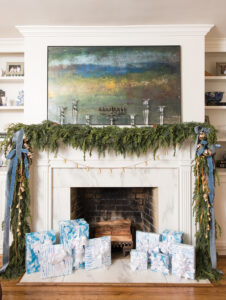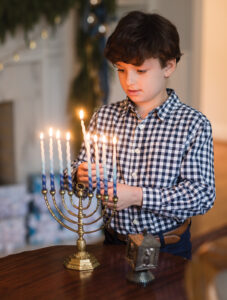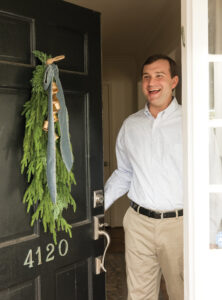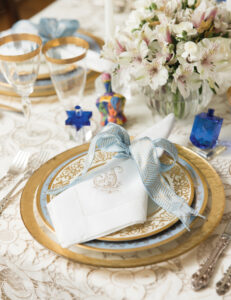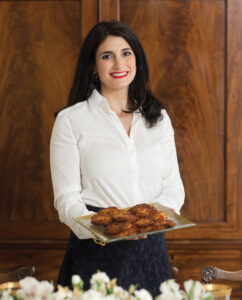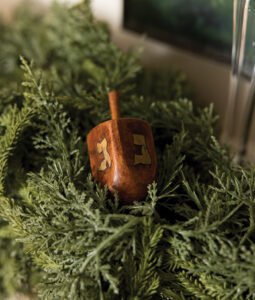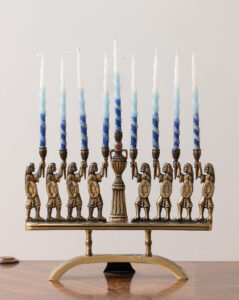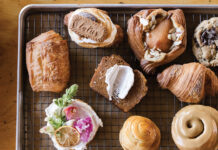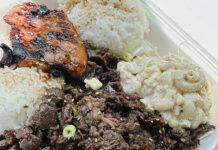Photos by Elizabeth Gelineau
The sun sets on a cool winter day as the Susman family gathers around the menorah, preparing to light the candles. In the background, the table is dressed for dinner, trays of time-honored holiday dishes at the center. The ornaments the children made at school adorn a fresh garland draped over the fireplace mantel, and dreidels, a traditional Hanukkah game involving a spinning top, are put aside in the name of reverence. Together, they sing blessings as they light the candles on their menorahs. The parents watch with delight as their children unwrap gifts by candlelight, each one a reminder of the joy of giving. This is Hanukkah in the Susman home — a celebration of light, family and heritage.
Jennifer and Peter Susman’s story of building a life together in Mobile began with a college romance. “My husband is from Mobile — born and raised — and I’m from Chicago originally. Both of us are Jewish, but we met at Southern Methodist University, which is kind of funny. But, being from Chicago, there’s a large Jewish population. I didn’t know what to expect in Mobile. There’s no denying that it’s a much smaller population, but it still has a very rich heritage.” In fact, Mobile is home to one of the nation’s oldest Reform Jewish congregations. In Mobile, they are very happy to have found a strong network of support and friendship. “We love being part of the Mobile Jewish community,” Jennifer said.
Mobilians from all walks of life have shown genuine curiosity and appreciation for the Susmans’ traditions. Jennifer has enjoyed speaking about Jewish customs at her children’s schools, and her friends relish the opportunity to participate in the family’s meaningful celebrations. “I’ve been invited to my kids’ school a number of times to talk about our Jewish traditions, in particular, Hanukkah,” says Jennifer. “During Hanukkah’s eight nights, we have friends or family over every night of the week. My kids’ friends love to come and light candles. We love having our friends come celebrate with us, and we love celebrating Christmas with them.”
Lighting candles during Hanukkah is more significant than just creating a festive ambiance — it’s a ritual that celebrates resilience, faith and miracles. The roots of the holiday date back over 2,000 years. Hanukkah commemorates the rededication of the Second Temple in Jerusalem after the Jewish warriors, known as the Maccabees, triumphed against oppressive forces. When they returned to restore holiness to the Temple by lighting the eternal flame, they found only a single day’s worth of consecrated oil. Miraculously, the oil kept the flame alight for eight nights until more sacred oil could be found or made.
Today, this miracle is honored by a ceremonial lighting of candles on a candelabra called a menorah, with one candle added each night until all eight are ignited. Using the shamash, or “helper” candle, families light each candle while reciting blessings that celebrate Hanukkah’s ancient history of hope. While most of the candles represent the eight nights of the “festival of lights,” the shamash symbolizes the act of sharing and spreading one’s light without diminishing one’s own flame. It’s a precept that Jennifer imparts to her children. “I think it’s a really important story to tell — about how one person, one leader, the Shamash candle, can light everyone else’s candles. It’s a really special lesson that I like to teach my children,” she says.
The miraculous oil isn’t just honored in candlelight — it also inspires many of the traditional foods enjoyed during Hanukkah. Lighter dishes served alongside fried treats keep meals balanced. “It’s called the Festival of Lights, but the story of Hanukkah is about the small bit of oil that sustained eight nights of light, so that the Temple could be rebuilt,” Jennifer says. “So, foods cooked in oil are traditional. Latkes, which are a type of potato pancake, are cooked in oil. We have something called sufganiyot, which is a little doughnut with jelly inside. It depends on where you’re from culturally, but we grew up dipping or topping our latkes with either applesauce or sour cream. I also make chicken soup this time of year because it’s typically cold. Every night is a celebration with the candles, but not every night is a big dinner. We just prepare something that we like to have and enjoy. And everyone likes traditional chicken soup, right?”
From left The Susman children receive one gift for every night of Hanukkah. This menorah depicts the Maccabees who experienced the miracle of the consecrated oil that lasted for eight days.
The spirit of Hanukkah spills off the plate into fun traditions and activities that everyone can enjoy. “We like having people over and playing dreidel, which is a type of wooden top with different symbols on each side that are letters with corresponding amounts of gelt, depending on where you land. Gelt is a chocolate candy covered in foil, and made to look like a coin. But you can play with anything, really. My son, in particular, loves playing dreidel. He sees it as an opportunity for him to get lots of Skittles. His friends like playing when they come over too.”
Though playing dreidel and eating indulgent foods are beloved Hanukkah traditions in the Susman household, not everyone celebrates the holiday in the same way. Jennifer and her family find joy in making it their own. “In the Jewish religion, there are many holidays that are considered religiously more significant than Hanukkah,” says Jennifer. “It just so happens that Hanukkah typically falls sometime around Christmas. As a result, I think it’s gained importance in the United States because it adopted some of the local culture and joy of Christmas time. We just like to make it the joy of Hanukkah time. So, it’s a much bigger holiday in the United States. But it’s another reason to celebrate, and we love celebrating.”
Decorations with familial value play a big role in the Susmans’ holiday celebrations. “While not all Jewish people decorate for Hanukkah, we do,” Jennifer says. “We try to find ways to celebrate the season with the same beautiful decorations as everyone else, but we make it our own and celebrate our traditions. For example, while we’ll put greenery over our fireplace, it’ll be with blue and gold accents with a menorah in it. My kids love it. You know, they make ornaments and stuff at school, and we love having the chance to display them.”
Heirloom pieces that have been inherited over generations are just as precious as the new holiday display pieces created by the youngest Susmans. “The china and utensils we use are part of our family history. We have a Menorah that was inherited from my husband’s side that was brought over from Germany, and it’s from the 1800s. It is very special to us. Then we have ones like my son’s menorah, which is a little sports-themed one, and he really enjoys lighting that. It is meaningful to represent our heritage and family history, and makes us feel connected with our past and our family while we’re celebrating these ancient traditions.”
For the Susmans, Hanukkah is a season of gratitude, both for their faith and for time spent with the people they cherish. “We have a lot of menorahs because we love to have our friends from different communities join us to celebrate, and their kids will get to light their own menorahs. Because we have eight nights, we get to do all of it. We have a fancy dinner with family or maybe people stop by for latkes and candles. We feel very fortunate in that way — that this holiday being spread out over eight days gives us eight different chances to celebrate however we want. We love sharing our Hanukkah traditions with our friends and family, just like we love celebrating their Christmas traditions with them.”
Latkes
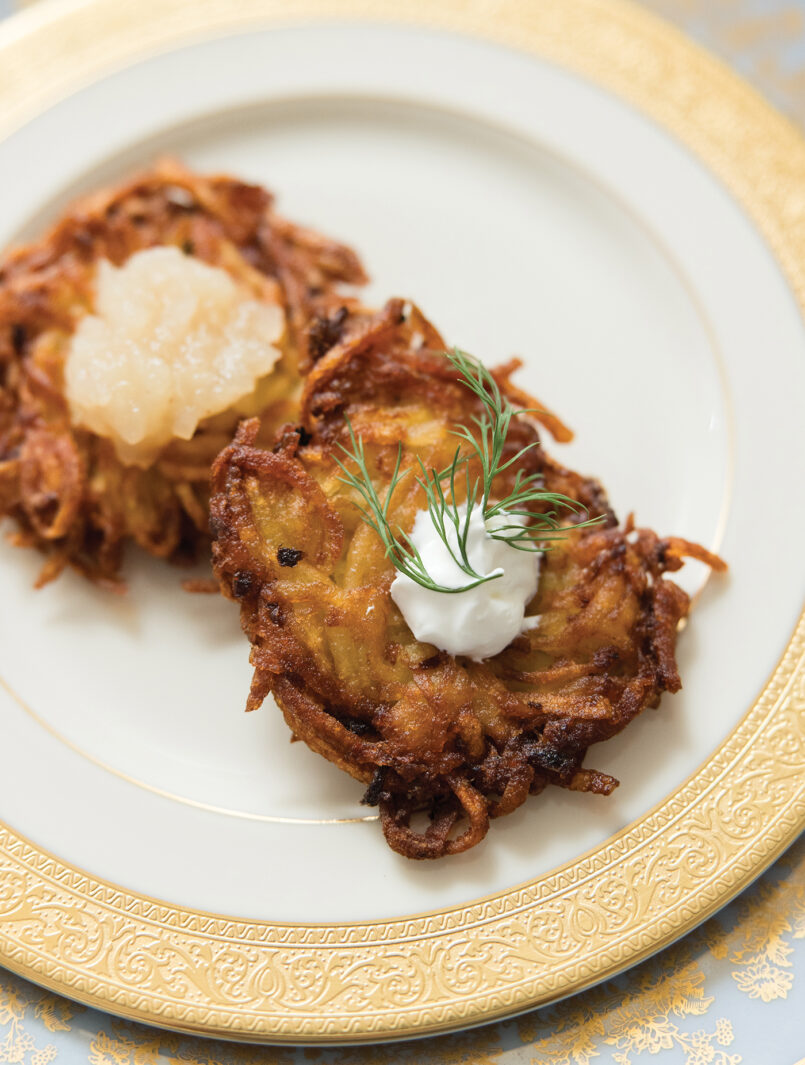
Serves 15
3 pounds Yukon gold potatoes, peeled and shredded
2 small yellow onions, shredded
1 1/2 teaspoons salt
1 1/2 teaspoons sugar
1 tablespoon all-pupose flour
2 eggs, lightly beaten
Canola oil for frying
Applesauce and sour cream, for serving
1. Combine potatoes and onions in cheese cloth and wring tightly until almost all the juice is gone. This may take multiple wrings.
2. In a large bowl, combine salt, sugar, flour and eggs with potatoes and onions, mixing until well combined.
3. Form mixture into 3-inch patties with hands, squeezing to bind and remove any remaining moisture.
4. Pour canola oil into a shallow pot, about 1 inch deep, and heat over medium-high heat.
5. Fry patties in canola oil over medium heat in batches, being careful not to crowd, until golden brown. Remove from oil and drain on a paper towel-lined plate. Serve warm with applesauce and sour cream on the side.
Applesauce
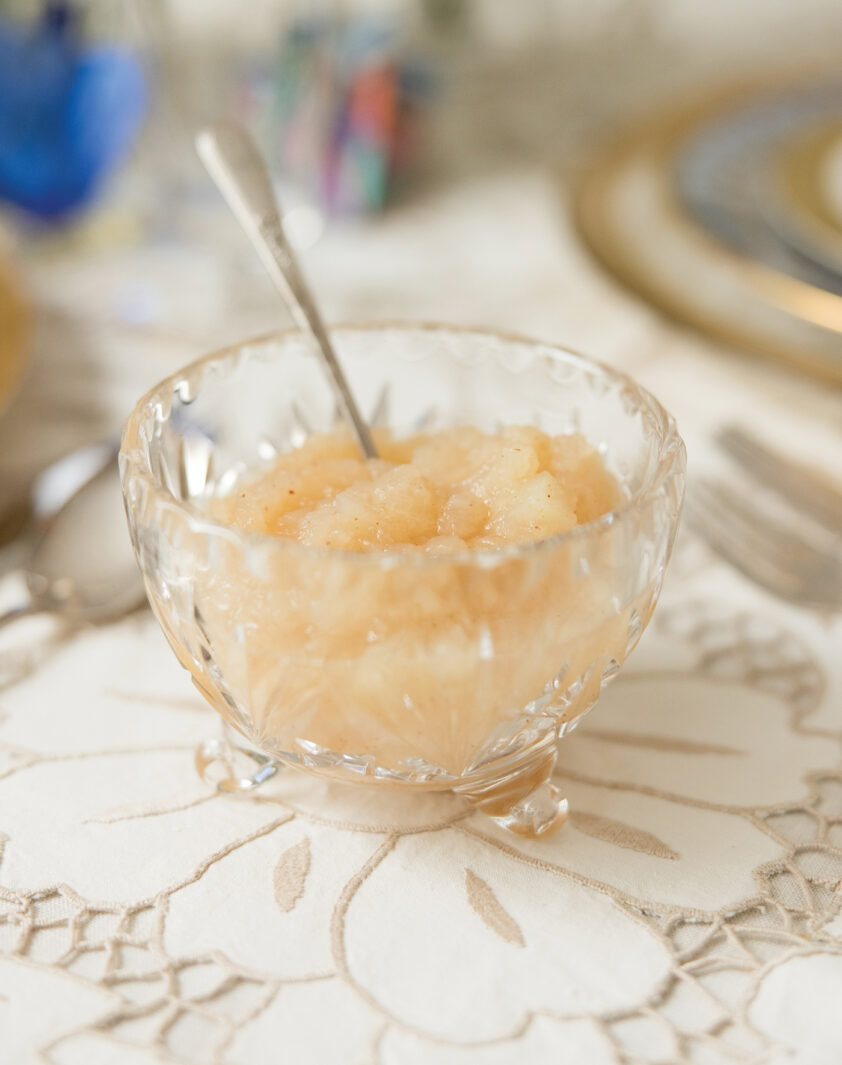
Serves 6 – 8
3 pounds of apples, any variety
1/2 teaspoons ground cinnamon
2 tablespoons sugar
3/4 cup water
2 teaspoons lemon juice
1. Wash, peel and core apples and chop into one-inch pieces.
2. Place chopped apples, cinnamon, sugar and water into a medium pot and cover with a lid.
3. Simmer ingredients over medium heat for 15 – 20 minutes, stirring occasionally until tender.
4. Mash or blend ingredients, depending on texture preference. Stir in lemon juice. Can be served warm or cool.
Chicken Soup (Jewish Penicillin)
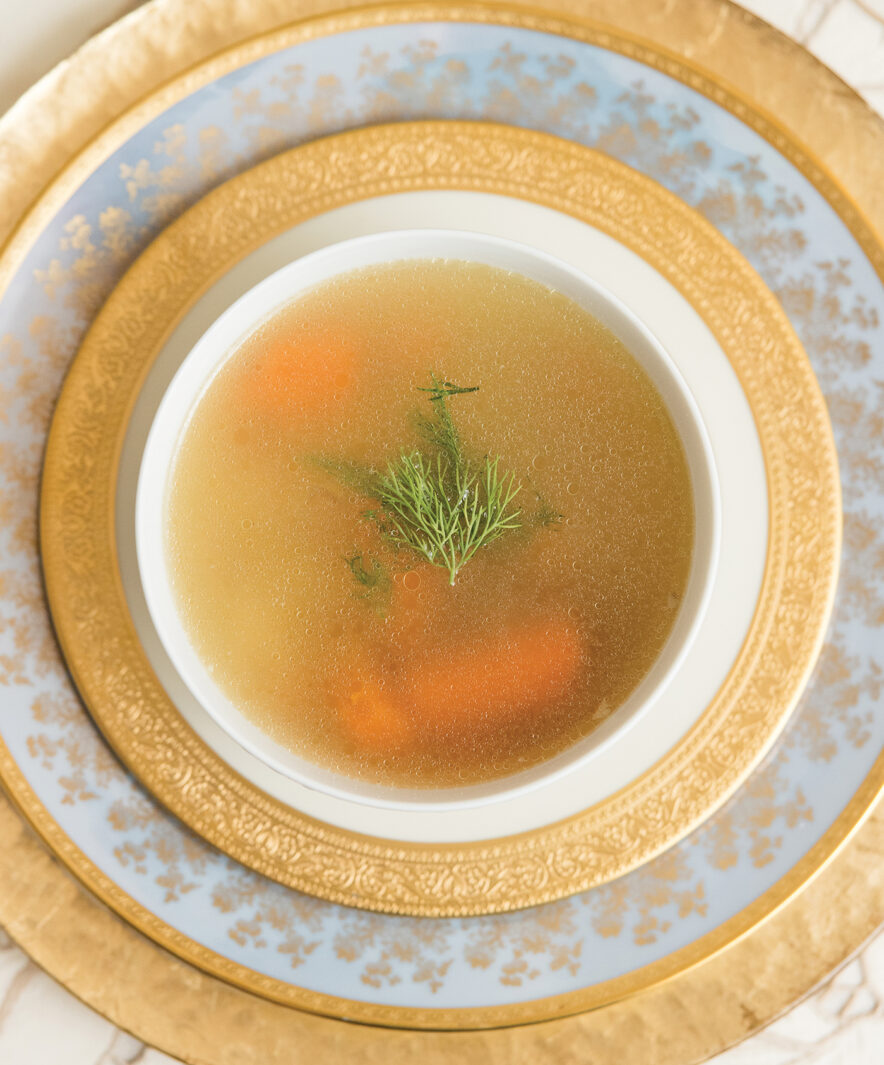
Serves 8 – 10
1 cut-up chicken, 4 – 5 pounds
4 quarts water
1 onion
3 celery bottoms, cut off of stalks
3 stalks of celery
2 – 3 sprigs parsley
3 large carrots, peeled
1 tablespoon salt
3 sprigs of dill
1. Wash chicken thoroughly. Bundle pieces in cheese cloth and tie closed with cooking twine.
2. In a large pot, combine water, whole onion, celery bottoms, celery stalks, parsley, salt, carrots and dill and bring to a boil over high heat. Skim the top layer of foam from the stock. Reduce heat and simmer for about three hours, skimming occasionally.
3. Remove chicken from the pot and strain the broth into a container. Shred chicken, discarding all bones and skin.
4. Return broth and chicken to the pot, adding the cooked onions and carrots,
if desired. Serve hot.

